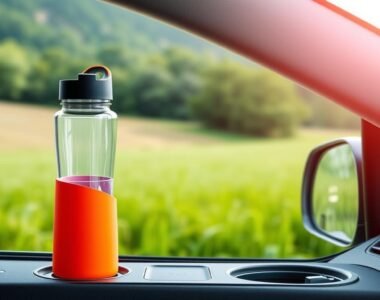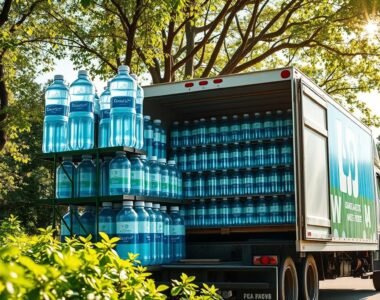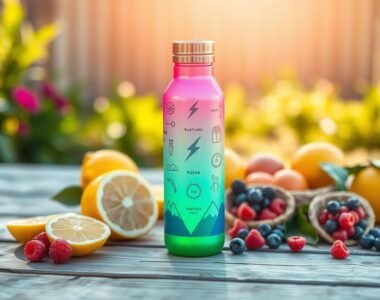No products in the cart.

Did you know that over 60% of the human body is water? This shows how vital staying hydrated is. It also makes us wonder, how many water bottles make up a gallon? In this guide, we’ll look at gallon conversion and how water bottle sizes compare. Knowing these details helps you stay hydrated easily.
Understanding Gallon Conversion
Knowing how to convert gallons is key for anyone working with liquids. A gallon is a common unit used in the U.S. to measure liquid volume. Let’s look at what it is and other units used for measuring liquids.
What is a Gallon?
A gallon is defined as 128 fluid ounces. It’s used for measuring large amounts of liquids. This is important in cooking, drinking, and industry. Knowing this helps us make better choices about liquids.
Liquid Measurement Units Explained
There are many units used with gallons in liquid measurement. Knowing how they compare helps us convert gallons more accurately. Here are some important ones:
| Unit | Equivalent to Gallons |
|---|---|
| Quarts | 1 Quart = 0.25 Gallons |
| Pints | 1 Pint = 0.125 Gallons |
| Liters | 1 Gallon ≈ 3.785 Liters |
| Fluid Ounces | 1 Fluid Ounce = 0.0078125 Gallons |
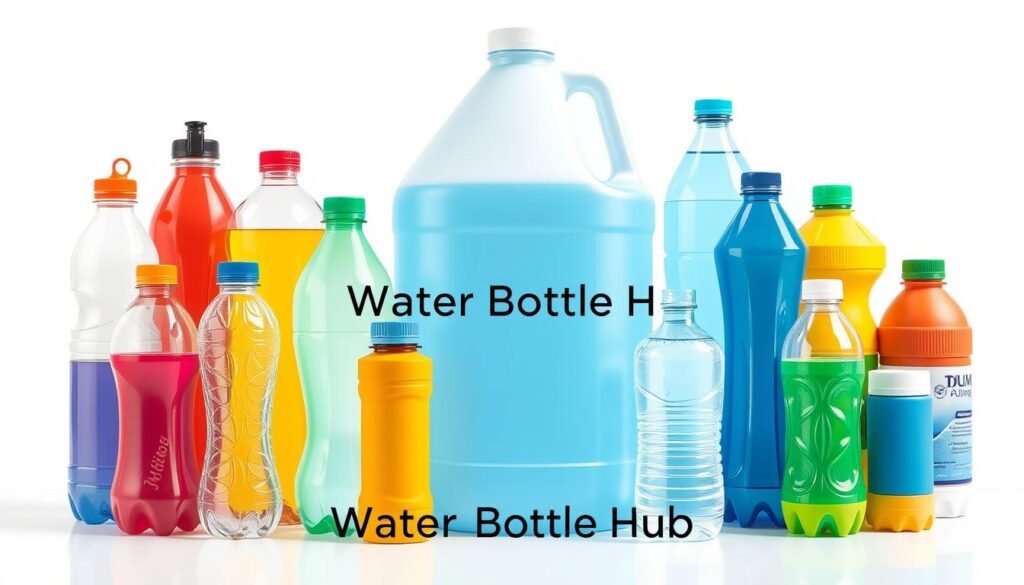
Learning about these units makes us more confident in measuring liquids. This is especially true when we need to be precise, like in cooking or tracking water intake. Understanding these basics makes measuring liquids easier.
How Many Water Bottles Is a Gallon
To figure out how many water bottles make a gallon, we need to know the sizes of water bottles. A typical plastic water bottle holds 16.9 fluid ounces. Since a gallon has 128 fluid ounces, it’s easy to measure water.

| Water Bottle Size (oz) | Volume in Gallons | Number of Bottles per Gallon |
|---|---|---|
| 16.9 | 1 gallon = 128 oz | 7.57 |
| 8 | 1 gallon = 128 oz | 16 |
| 24 | 1 gallon = 128 oz | 5.33 |
This table shows how different bottle sizes add up to a gallon. Knowing this can help you stay hydrated all day.
Water Bottle Size Variations
Choosing the right water bottle size is key to staying hydrated. The market has many sizes, especially plastic ones. Knowing what size you need is important for both your health and the planet.
Common Sizes of Plastic Water Bottles
Plastic water bottles come in standard sizes. Here are some common ones:
- 16.9 ounces (500 ml)
- 24 ounces (710 ml)
- 32 ounces (946 ml)
- 64 ounces (1.89 liters)
Each size meets different needs. From small bottles for workouts to big ones for long trips. Knowing these sizes helps figure out how many bottles you need to drink a gallon a day.
Differences Between Reusable and Disposable Bottles
Choosing between reusable and disposable bottles affects your habits and the environment. Reusable bottles last longer and are made from durable materials. Disposable bottles, on the other hand, are made for one-time use and add to waste.
| Feature | Reusable Bottles | Disposable Bottles |
|---|---|---|
| Material | Stainless steel, glass, or BPA-free plastic | Single-use plastic |
| Durability | Long-lasting | Short-term use |
| Environmental Impact | Lower waste through repeated use | Higher waste; contributes to plastic pollution |
| Cost | Higher initial cost, but savings over time | Lower initial cost, can be more expensive long-term |
Choosing wisely between reusable and disposable bottles improves your hydration and helps the environment. Knowing about water bottle sizes helps you pick the best one for you.
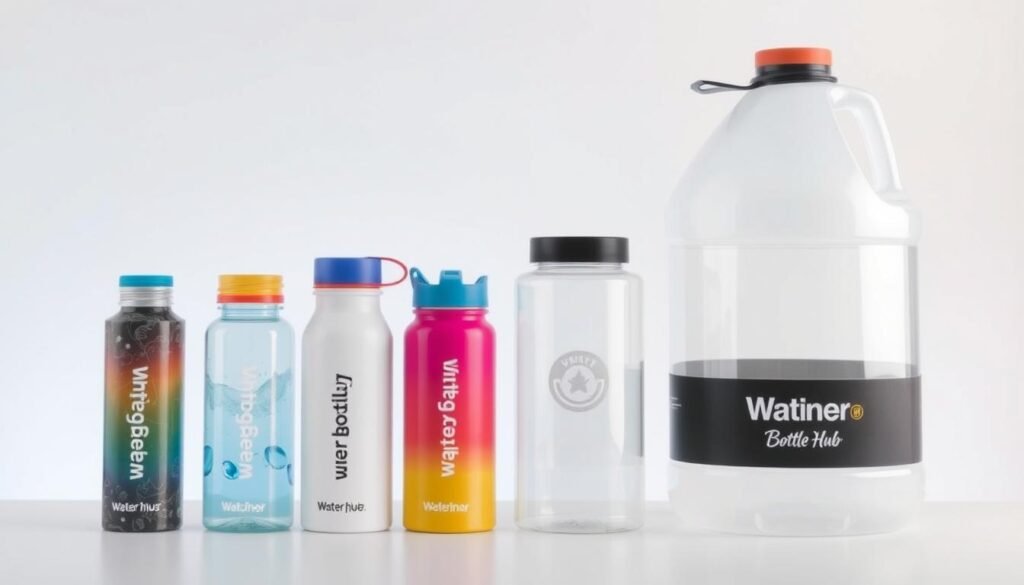
Calculating Bottle Capacity
Knowing how much water your bottle holds is key for staying hydrated. It’s easy to figure out how much water you need by converting fluid ounces to gallons. This guide will show you how to measure water accurately with different bottle sizes.
Fluid Ounces to Gallons Conversion
Understanding the switch from fluid ounces to gallons is vital for drinking enough water. Since there are 128 fluid ounces in a gallon, you can convert them by dividing:
Gallons = Fluid Ounces ÷ 128
Let’s say you have a 32-fluid-ounce bottle. To find out how many gallons it is, you do this:
32 ÷ 128 = 0.25 gallons
This simple trick helps you stay on top of your water intake.
How to Measure Water Using Bottles
Measuring water is easy with the right bottle sizes. Here are some helpful tips:
- Choose standard bottles: Pick bottles with clear measurements. They usually show fluid ounces or liters, making it simple to see how much water you have.
- Mark smaller bottles: If you have a small bottle without measurements, fill it with known amounts. Then, mark those levels for future use.
- Convert when needed: For bottles that aren’t standard, remember to convert fluid ounces to gallons. This ensures you drink enough water.
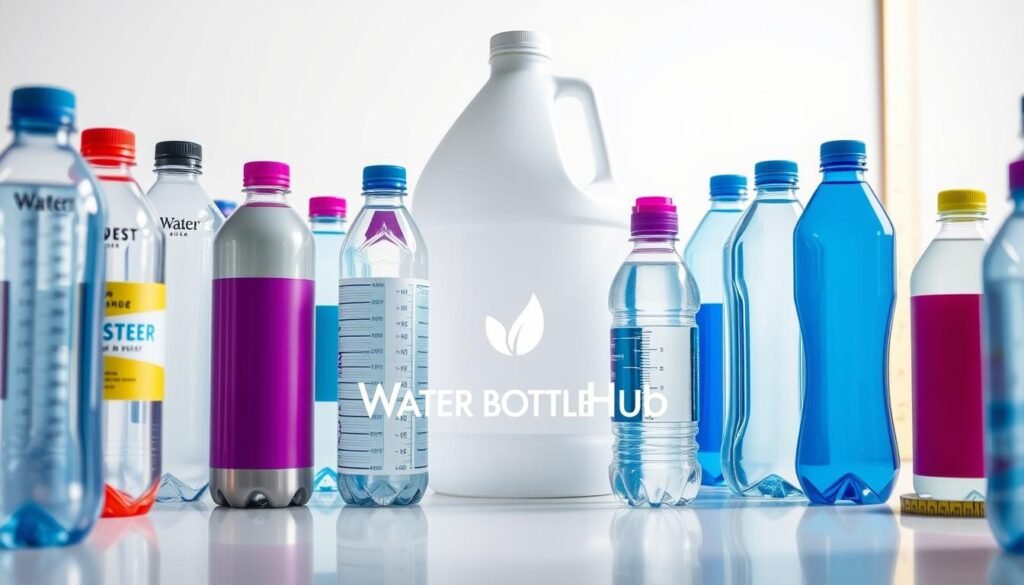
Hydration Requirements for Adults
It’s important to know how much water we need to stay healthy. Adults have specific amounts to drink each day. Men should aim for about 3.7 liters, and women for 2.7 liters. This is roughly 13 cups for men and 9 cups for women.
Drinking enough water helps our bodies work well and boosts our energy. It’s key for staying healthy and active.
Daily Water Intake Recommendations
How much water we need changes based on our age, sex, and lifestyle. It’s crucial to follow these guidelines for good hydration. Keeping track of our water intake helps us stay on target.
Drinking a variety of fluids and eating hydrating foods also helps. These habits support our overall health and performance.
Factors Influencing Hydration Needs
Many things affect how much water we need. The weather, how active we are, and our diet all play a part. For example, intense exercise makes us sweat more, so we need more water.
People living in hot, humid places might need even more water. Also, foods high in sodium and caffeine can make us thirstier. Knowing these factors helps us stay hydrated.

Benefits of Drinking a Gallon of Water Daily
Drinking a gallon of water daily can greatly improve your health. It helps with digestion by breaking down food. This makes it easier for your body to absorb nutrients and avoid constipation.
Drinking enough water also makes your skin look better. It keeps your skin from getting dry and makes it glow. If you’re tired a lot, drinking a gallon of water can help. It keeps your energy up, especially when you’re active.
Drinking water also helps with weight management. It can make you feel full, helping you eat less. This can lead to making healthier food choices all day.

Adding lots of water to your day can make you healthier. Drinking a gallon of water daily can boost your well-being. It also helps you stay focused and productive.
| Health Benefit | Description |
|---|---|
| Improved Digestion | Water aids in breaking down food, promoting better nutrient absorption. |
| Enhanced Skin Health | Proper hydration leads to reduced dryness, resulting in a healthier complexion. |
| Better Energy Levels | Maintaining hydration combats fatigue, improving overall energy. |
| Weight Management | Water acts as an appetite suppressant, helping control caloric intake. |
Plastic Bottle Recycling: A Quick Overview
Recycling plastic bottles is key to protecting our planet and teaching us to live sustainably. The huge amount of plastic waste we make every day harms our environment. It’s vital for all of us to learn how to recycle properly.
By recycling plastic bottles, we cut down on waste and lessen the harm caused by making and throwing away plastic.
The Importance of Reducing Plastic Waste
Our world uses a lot of plastic, leading to big problems. Every minute, over 1 million plastic bottles are used, adding up to 300 million tons of waste each year. Recycling plastic bottles helps reduce this waste and keeps our environment cleaner.
- Most plastic bottles can be recycled, but only 29% are.
- Recycling one ton of plastic saves about 7.4 cubic yards of landfill space.
- Using and recycling plastic saves 75% of energy compared to making new plastic.
Many recycling programs aim to get more people to recycle. They teach us about the benefits of recycling and how to dispose of waste properly. Together, we can make a big difference in reducing plastic waste’s harm to our planet.
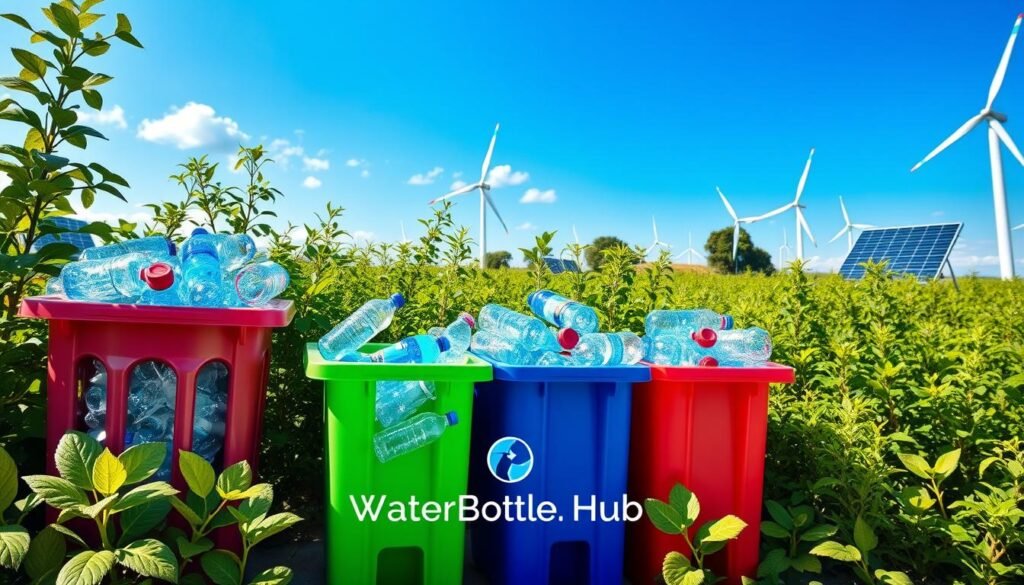
| Year | Plastic Waste Generated (Million Tons) | Recycled Percentage (%) |
|---|---|---|
| 2020 | 300 | 29 |
| 2021 | 350 | 31 |
| 2022 | 370 | 33 |
Recycling plastic bottles is not just about doing the right thing. It’s about joining a bigger effort to reduce waste and protect our environment. Every small action we take helps make a big difference.
Reusable Bottle Alternatives
Looking into reusable bottle alternatives shows many options that are good for you and the planet. More people now choose sustainable options because of the harm single-use water bottles cause. Knowing what materials reusable bottles are made of helps us pick eco-friendly ones.
Popular Materials for Reusable Bottles
Reusable bottles are often made of stainless steel, glass, or BPA-free plastic. Each has its own benefits:
- Stainless Steel: It’s tough, doesn’t rust, keeps drinks hot or cold, and is safe for liquids.
- Glass: It’s fully recyclable, safe, doesn’t change the taste of drinks, and is easy to clean.
- BPA-Free Plastic: It’s light, won’t break easily, is cheaper, and comes in many designs and colors.
Environmental Impact of Reusable Bottles
Using reusable bottles instead of single-use ones greatly reduces plastic waste. This move helps fight pollution and landfill problems. Each reusable bottle helps make our planet a bit healthier.
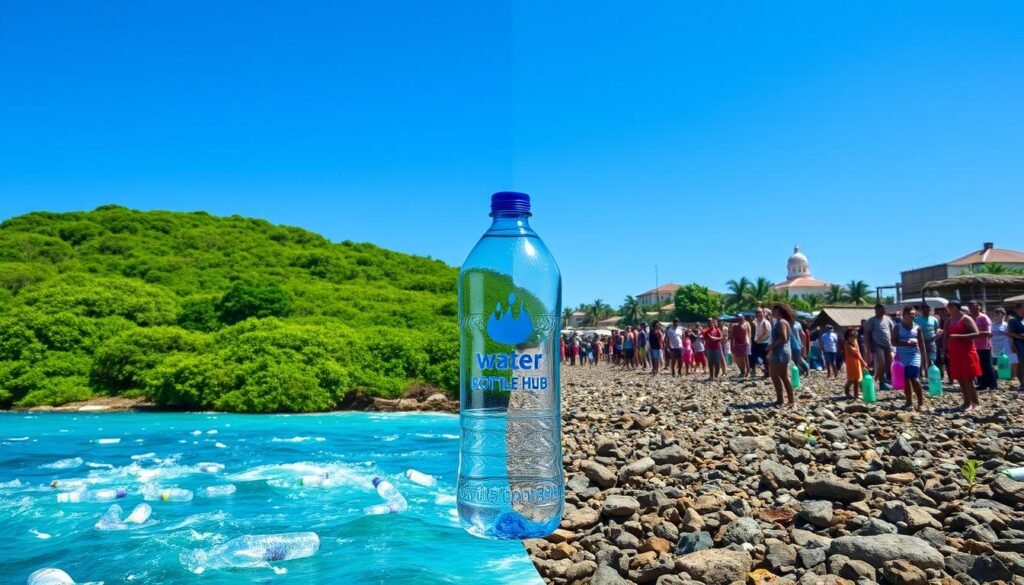
Adding reusable bottles to our daily lives is good for us and the planet. Choosing the right materials for these bottles is key to a greener future.
| Material | Durability | Eco-Friendliness | Temperature Retention |
|---|---|---|---|
| Stainless Steel | High | Recyclable | Excellent |
| Glass | Medium | 100% Recyclable | Good |
| BPA-Free Plastic | Low to Medium | Can be recycled | Poor |
Liquid Volume Calculation Made Easy
Knowing how to calculate liquid volume is key for good hydration. With the right formula and tips, figuring out water bottle needs is easy.
First, it’s good to know water bottle sizes. A standard bottle holds 16.9 ounces. Bigger ones can hold up to 32 ounces or a full gallon. Here’s a simple formula for hydration:
- 1 gallon = 128 ounces
- For a 16.9-ounce bottle: 128 / 16.9 ≈ 7.6 bottles
- For a 32-ounce bottle: 128 / 32 = 4 bottles
This method makes it clear how to meet your hydration goals. It works for any bottle size, helping you drink enough water.
Using these methods makes hydration easier. By adding liquid volume calculation to your daily routine, you’ll stay energized and healthy.
Choosing the Right Water Bottle
Finding the perfect water bottle can really improve your hydration. There are many features and options out there. It’s key to know what to look for to make the best choice. Here are some important things to consider:
Features to Look for in a Water Bottle
- Insulation: If you like cold or hot drinks, look for bottles with double-wall insulation.
- Portability: A lightweight design with built-in handles or carabiners makes it easy to carry on the go.
- Material: Stainless steel, glass, or BPA-free plastic offer different levels of durability and ease of cleaning.
- Leak-Proof Design: A secure cap or lid keeps your bottle from spilling when you move it.
- Size: Pick a size that fits your hydration needs without being too big or heavy.
Popular Brands and Their Bottle Sizes
Many water bottle brands are popular for their quality and variety. Here’s a quick look at some top brands:
| Brand | Common Sizes | Features |
|---|---|---|
| Nalgene | 16 oz, 32 oz, 48 oz | BPA-free, wide mouth for easy filling and cleaning |
| Hydro Flask | 12 oz, 18 oz, 21 oz, 32 oz, 64 oz | Double-wall vacuum insulation, powder coat finish |
| CamelBak | 20 oz, 25 oz, 50 oz | Built-in straw, spill-proof cap, lightweight design |
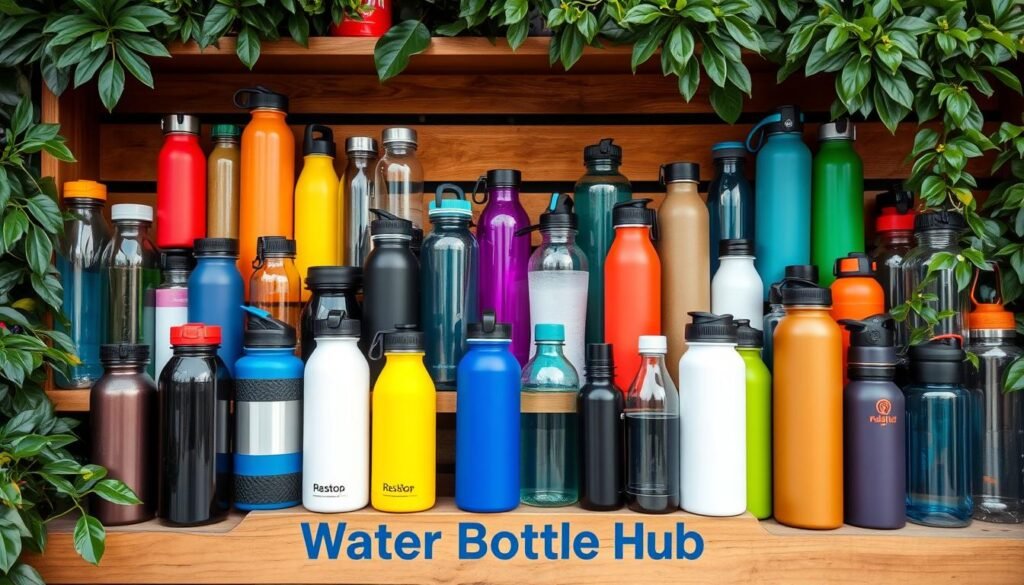
Conclusion
Understanding gallon conversions and water bottle sizes is key for staying hydrated. This article has shown how many water bottles make up a gallon. It also covered the different sizes you can find and how to track your water intake.
Drinking enough water is not just about staying hydrated. It also helps with digestion, boosts energy, and keeps your skin healthy. Using this knowledge, you can choose the right water bottles for your needs. Choosing eco-friendly options is good for the planet and your health.
Remember, every small step towards better hydration can make a big difference. Adopting these habits can lead to a healthier, more active life.
FAQ
How many water bottles make up a gallon?
A standard 16.9-ounce water bottle is needed about 7.57 times to equal one gallon.
What is the importance of understanding gallon conversion?
Knowing how to convert gallons helps you stay hydrated. It ensures you drink enough water each day.
What are the common sizes of plastic water bottles?
Plastic water bottles come in 16.9, 24, and 32 ounces. Each size affects how much water you can carry and drink.
How do I measure water using bottles?
To measure water, check the bottle’s ounces. Then, figure out how many bottles you need to drink enough water.
What factors influence hydration requirements?
Hydration needs change based on activity, weather, and what you eat. These factors affect how much water you need every day.
What are the benefits of drinking a gallon of water daily?
Drinking a gallon daily can improve digestion and skin health. It also boosts energy and helps with weight management, leading to better overall health.
Why is plastic bottle recycling important?
Recycling plastic bottles is key to reducing waste. It helps protect our planet by cutting down on single-use plastics.
What are some popular materials for reusable bottles?
Reusable bottles are made from stainless steel, glass, and BPA-free plastics. Each material has its own health and environmental benefits.
How can I easily calculate liquid volume?
To calculate liquid volume, use simple math. This helps you figure out how many bottles you need for your daily water goal.
What features should I look for when choosing a water bottle?
When picking a water bottle, look for insulation, portability, material quality, and design. These features ensure the bottle meets your hydration needs.
Which brands are popular for water bottles?
Popular brands include Nalgene, Hydro Flask, and CamelBak. They offer various sizes and features to fit different preferences.

